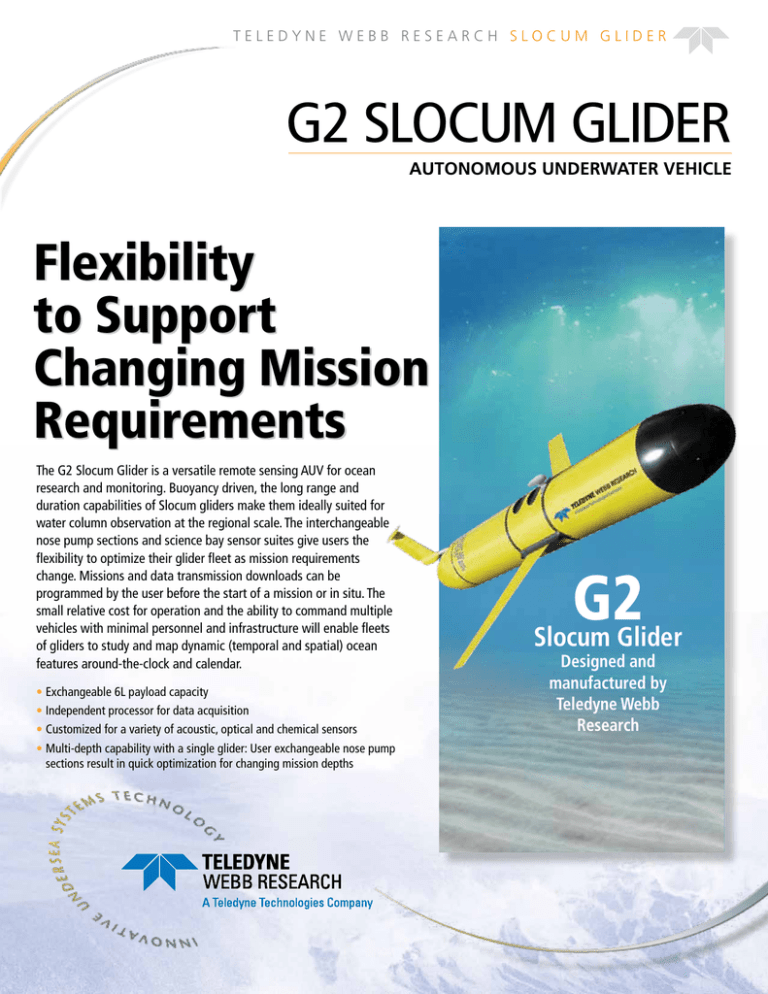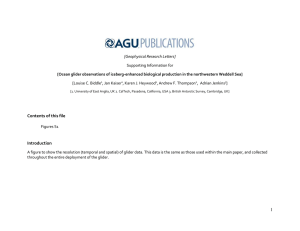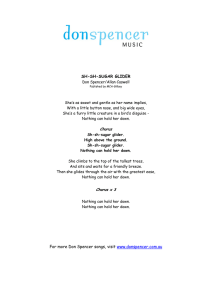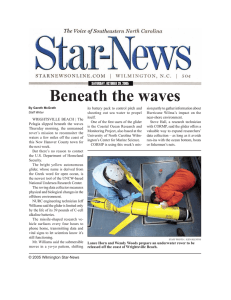G2 SLOCUM GLIDER
advertisement

TELEDYNE WEBB RESEARCH SLOCUM GLIDER G2 SLOCUM GLIDER AUTONOMOUS UNDERWATER VEHICLE Flexibility to Support Changing Mission Requirements The G2 Slocum Glider is a versatile remote sensing AUV for ocean research and monitoring. Buoyancy driven, the long range and duration capabilities of Slocum gliders make them ideally suited for water column observation at the regional scale. The interchangeable nose pump sections and science bay sensor suites give users the flexibility to optimize their glider fleet as mission requirements change. Missions and data transmission downloads can be programmed by the user before the start of a mission or in situ. The small relative cost for operation and the ability to command multiple vehicles with minimal personnel and infrastructure will enable fleets of gliders to study and map dynamic (temporal and spatial) ocean features around-the-clock and calendar. • Exchangeable 6L payload capacity • Independent processor for data acquisition • Customized for a variety of acoustic, optical and chemical sensors • Multi-depth capability with a single glider: User exchangeable nose pump sections result in quick optimization for changing mission depths G2 Slocum Glider Designed and manufactured by Teledyne Webb Research TELEDYNE WEBB RESEARCH SLOCUM GLIDER G2 Slocum Glider SENSOR OPTIONS: Previously integrated sensors • Acoustic Bioprobe • Acoustic Doppler Current Profiler (ADCP) • Acoustic Modem • Acoustic Mammal Detection • Bathyphotometer (bioluminescence) • Beam Attenuation Meter • CTD Pumped • Hydrophones • Optical Backscatter • Optical Attenuation • Optical Fluorometer • Oxygen • PAR • Radiometer • Spectrophotometer for harmful algal blooms (e.g., Red Tide) • Turbulence CAPABILITIES • Waypoint transect • Virtual mooring • Gateway glider acoustic link • Storm sampling • Coordinated fleet • As part of Teledyne Marine, access to engineers and technology for advanced sensor capability and future sensor developments Slocum Glider systems include all tools (hardware and software) required for deployment, mission planning, command and control, and data retrieval. General Specifications Deployment Versatile, maneuverable deployment with 1-2 people Power Alkaline (A) or Lithium (L) batteries Range 600 - 1500 km (A) / 4000 - 6000 km (L) Deployment Length 15-50 days (A) / 4 - 8 months (L) Configuration Options (4 to 200m) or (40 to 1000m) operating depth range* Navigation GPS Waypoints, Pressure Sensor, Altimeter Communication RF Modem, Iridium (RUDICS), ARGOS, Acoustic Modem Speed .35 m/s (0.68 knot) Average Horizontal Mass 54 kgs Dimensions Vehicle Length: 1.5 meters; Hull Diameter 22 cm * Nose section dependent Note: Endurance and range dependent on sensors and sampling frequency, energy source and communications. Figure 1. The Slocum glider uses hydraulic buoyancy change to alter the vehicle density in relation to the surrounding water thereby causing the vehicle to either float or sink. Given an appropriate dive or climb angle, the wings and body lift convert some of this vertical motion into a forward sawtooth horizontal motion. Altimeter or pressure inflects the glider in relation to the bottom or a specified depth as it undulates throughout the water column collecting sensor data. Per pre-programmed mission, the glider periodically surfaces, inflating an air bladder to raise the tail fin antennae out of the water. The glider then calls via Iridium Satellite Phone (anywhere in world) or Free Wave RF Modem (line of sight) in to Dockserver (auto attendant computer) to relay navigational fix, data and receive further instructions for command and control. Gliders can be flown in a coordinated fleet to meet a spacial and temporal objective, along transects, or as virtual moorings. Additional Features www.webbresearch.com • User exchangeable nose pump section • Nose recovery system • Recovery strobe light • Extendable payload bay for sensors or additional energy requirements 82 Technology Park Drive, East Falmouth, MA 02536-4441 USA Tel +1 508.548.2077 • Fax +1 508.540.1686 • E-mail: webbresearch@teledyne.com Specifications subject to change without notice. 9/2010. ©2010 TELEDYNE Webb Research, Inc. Other products and company names mentioned herein may be trademarks and/or registered trademarks. TELEDYNE WEBB RESEARCH • A MEMBER OF TELEDYNE MARINE


